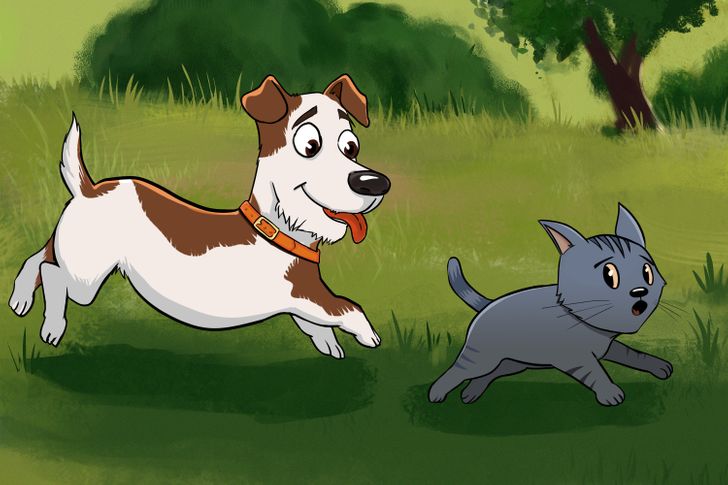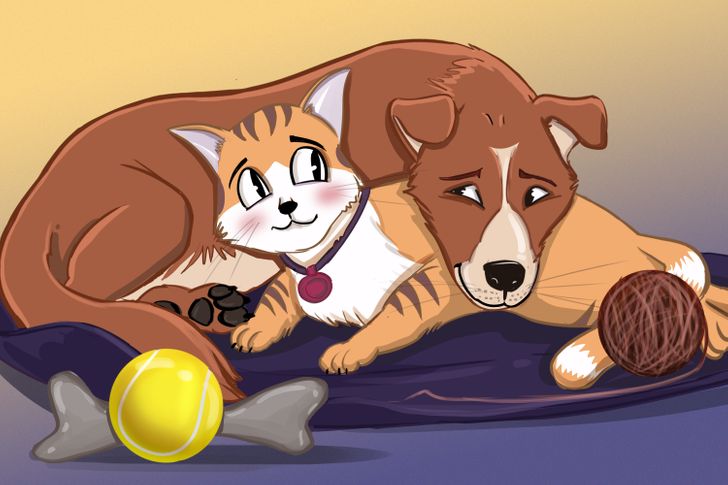Why Cats and Dogs Don’t Like Each Other
There is a saying “they fight like cats and dogs,” and it often reflects the reality of the relationship between these 2 animals. However, when your cat and dog live in the same house, they can be really good friends. So, why does this happen?
5-Minute Crafts decided to find out why our favorite pets fight, and how to prevent these conflicts.
Natural instincts

Dogs have a natural instinct to chase small animals that try to run away from them, which is what cats do when trying to avoid open confrontation. Sometimes, however, cats can take more drastic measures: start hissing, arching their backs, and even swiping at the dog with their paws — claws fully extended of course. When confronted by this behavior, some dogs will respond by becoming afraid of cats in general.
❗️ Do not reward the dog’s behavior when it chases the cat and tries to harm it in any way. This type of relationship between these animals can lead to sad consequences. These pets can live well together, there is no need to provoke aggression between them.
Behavioral differences

The main reason why cats and dogs fight lies in their fundamentally different behavior. They speak completely different languages.
Dogs are very mobile and behave like children: they want to run and play. This is the way they usually approach cats. Cats, in turn, are wary and suspicious. They freak out and defend themselves when they are suddenly attacked, not realizing that dogs just want to play with them. When a dog realizes that it is being treated in an unfriendly manner, it either leaves or begins to act in the same way.
Here are some examples of how their behavior differs:
- Greeting
Cats walk straight at each other, tails up, look into each other’s eyes, blink slowly to show that they mean no harm.
Dogs run around each other, wag their tails, and avoid eye contact, indicating that they have come in peace. - Tail wagging
Cats do this when they are scared or aggressive.
Dogs show their friendliness and excitement this way. - Running
Cats don’t run for fun. Usually, if they are running, it means that they are scared, aggressive, or in a hurry.
While dogs just love to run — this is one of their favorite activities.
The rules of living together

After interacting with each other at home, a dog and a cat can become best friends. Once that happens, don’t be surprised to see them curled up together while sleeping. If the dog has a new toy, it can share it with the cat. However, the cat won’t do the same in return. Besides, in such a close relationship, the cat may regard “pursuit” as part of the game. In this case, the animals can even change places, so the dog will be the one who is chased.
However, it is important to remember a few rules:
- Each pet should have their own territory where they can relax and be alone. The dog is unlikely to encroach on the cat’s sleeping place, but the cat, in turn, can calmly lie down on the dog’s bed.
- Teach your dog to control its natural instincts that can harm your cat. Don’t introduce the dog to a new pet until it has been properly trained. If you do everything right, then it’s very unlikely that one of the pets will be harmed.
- Feed the pets on the same schedule. At the same time, keep in mind that their eating places should be separate. Cat food is not good for dogs and dog food is not good for cats. If you follow this rule, the pets are unlikely to get into each other’s bowls.
- Spend time with each of them separately. When you are walking the dog, the second pet should not be nearby. The cat wants your undivided attention too so the dog shouldn’t be allowed to interfere.
- Sometimes instincts can take over, and the pets may show aggression toward each other. This is normal. If their relationship is close enough, they won’t seriously harm each other.
💡 Recommendation: Ideally when they first meet, the cat or the dog, or both of them should be less than a year old. The younger the animal, the easier it is for it to adapt to a new family member.